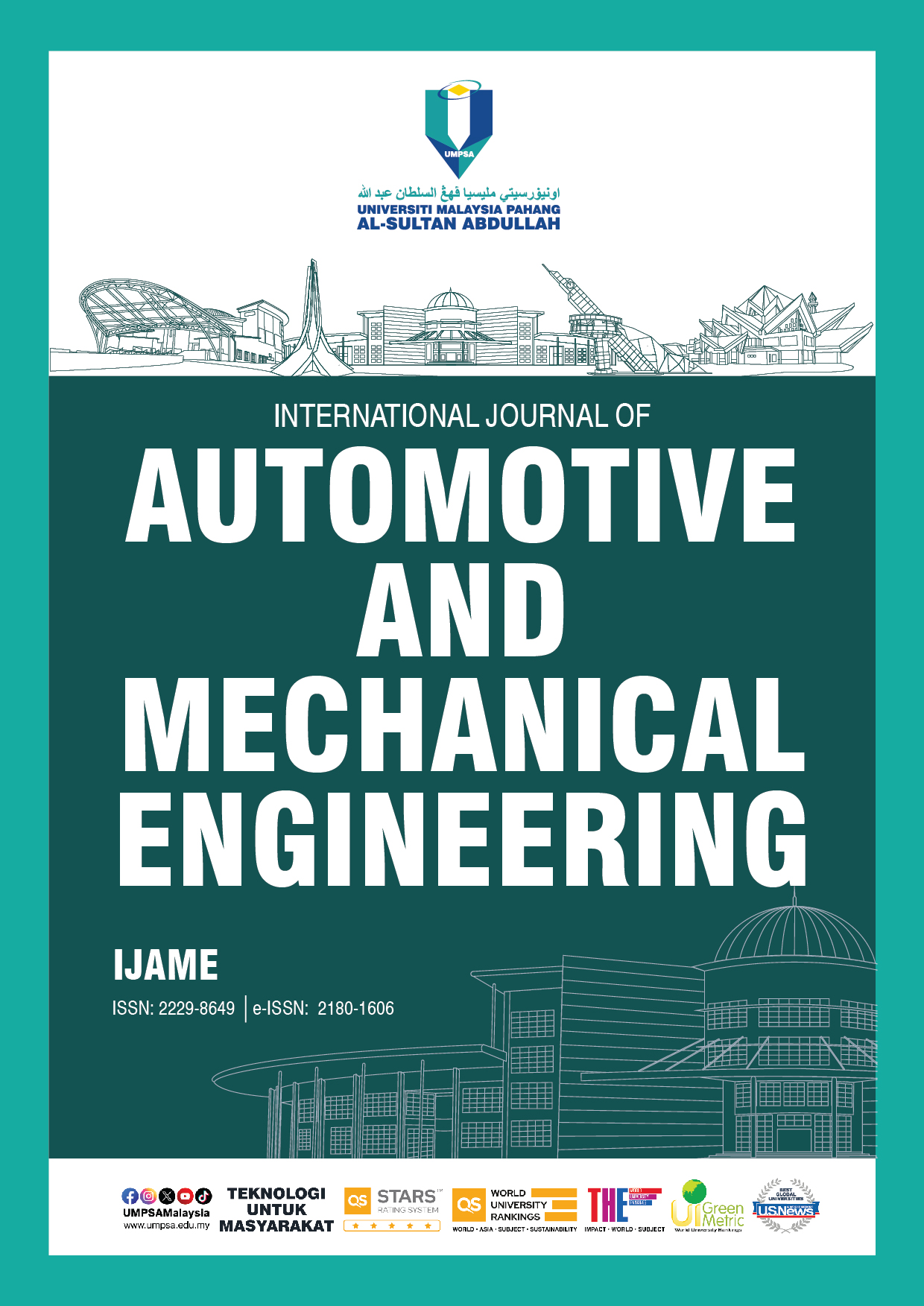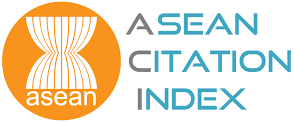Strength and Reliability of Adhesive-Bonded Joints in Semiconductor Packaging: A Computational Analysis
DOI:
https://doi.org/10.15282/ijame.22.2.2025.17.0954Keywords:
Adhesive Bonded Joints, Numerical Analysis, Nano Bond Thickness, Stress Singularity, Chipset PackagingAbstract
Adhesive bonded joints are increasingly used in various industries due to their enhanced structural integrity and reliability. However, successful implementation depends on understanding factors such as bond thickness. It is in fact a crucial parameter for strength and reliability. By exploring the bond thickness and joint strength relationship, strategies can be developed to overcome vulnerabilities in the semiconductor industry, especially in chipset packaging. This study presents enhanced joint designs and their reliability. Computational analysis of adhesive-bonded joints with polymorphic bond thickness is carried out using the Finite Element Method to study the effects of bond thickness. Three-dimensional models of the adhesive-bonded connections are being developed using software with bond thicknesses ranging from 1 nm to 100 nm. Results show that at 100 nm thickness, the maximum normal stress reached approximately 3.66 MPa at the GaN-resin interface, compared to 2.55 MPa at the InN-resin interface. Shear stress peaked symmetrically around 45°, while displayed sharp drops from peak values near 0° to almost zero by 90°, depending on thickness. Stress singularity intensity decreased as adhesive thickness was reduced, indicating less stress concentration. Notably, joints with GaN exhibited 43.5% higher peak stress values compared to InN under identical conditions. This study elucidates insights regarding the intricate relation between resin thickness and joint performance, shedding light on their mechanical behavior and providing valuable data on the modal analysis for different substrates. Overall, the study reveals that varying resin thicknesses significantly affect stress distribution and vibrational behavior in adhesive-bonded joints, providing insights into joint performance and potential improvements in modern engineering.
References
[1] M.D. Banea and L.F.M. Da Silva, “Adhesively bonded joints in composite materials: an overview,” Proceedings of the Institution of Mechanical Engineers, Part L: Journal of Materials: Design and Applications, vol. 223, no. 1, pp. 1-18, 2009.
[2] W. Guo, P. Chen, L. Yu, G. Peng, Y. Zhao, and F. Gao, “Numerical analysis of the strength and interfacial behaviour of adhesively bonded joints with varying bondline thicknesses,” International Journal of Adhesion and Adhesives, vol. 98, p. 102553, 2020.
[3] L.F.M. Da Silva, A. Öchsner, and R.D. Adams, “Introduction to adhesive bonding technology,” in Handbook of Adhesion Technology, L. F. M. da Silva, A. Öchsner, R. D. Adams, Berlin, Heidelberg: Springer, 2011, pp. 1-7.
[4] L. Guo, J. Liu, H. Xia, X. Li, X. Zhang, and H. Yang, “Effects of surface treatment and adhesive thickness on the shear strength of precision bonded joints,” Polymer Testing, vol. 94, p. 107063, 2021.
[5] D.B. Lee, T. Ikeda, N. Miyazaki, and N. Choi, “Effect of Bond Thickness on the Fracture Toughness of Adhesive Joints,” Journal of Engineering Materials and Technology, vol. 126, no. 1, pp. 14-18, 2004.
[6] L. Liao, C. Huang, and T. Sawa, “Effect of adhesive thickness, adhesive type and scarf angle on the mechanical properties of scarf adhesive joints,” International Journal of Solids and Structures, vol. 50, no. 25, pp. 4333-4340, 2013.
[7] X. Shen, Z. Xia, and F. Ellyin, “Cyclic deformation behavior of an Epoxy polymer. Part I: Experimental investigation,” Polymer Engineering & Science, vol. 44, pp. 2240-2246, 2004.
[8] B. Chen, Q. Yuan, and J. Luo, “Stress concentration in adhesive layer of adhesively bonded piezoelectric pipe-joint system,” Journal of Superconductivity and Novel Magnetism, vol. 23, no. 6, pp. 945-947, 2010.
[9] C. Lin and K. M. Liechti, “Similarity concepts in the fatigue fracture of adhesively bonded joints,” The Journal of Adhesion, vol. 21, no. 1, pp. 1-24, 1987.
[10] H. Koguchi and K. Yokoyama, “Stress analysis in three-dimensional joints with a crack at the vertex of the interface,” Acta Mechanica, vol. 228, no. 8, pp. 2759-2773, 2017.
[11] M. Uddin, M. Ali, and H. P. Chan, “Achieving optimum adhesion of conductive adhesive bonded flip-chip on flex packages,” Reviews on Advanced Materials Science, vol. 21, pp. 165-172, 2009.
[12] H. Koguchi and J. A. da Costa, “Analysis of the stress singularity field at a vertex in 3D-bonded structures having a slanted side surface,” International Journal of Solids and Structures, vol. 47, no. 22, pp. 3131-3140, 2010.
[13] M. S. Islam and H. Koguchi, “Analysis of intensity of singularity at a vertex in 3d transversely isotropic piezoelectric bimaterial joints by boundary element method,” in 2013 International Conference on Informatics, Electronics and Vision (ICIEV), Dhaka, Bangladesh, 2013.
[14] M. S. Islam, M. G. Kader, M. M. K. Uddin, and M. Ahmed, “Analysis of order of stress singularity at a vertex in 3d transversely isotropic piezoelectric dissimilar bonded joints,” Journal of Mechanical Engineering, vol. 44, no. 1, pp. 1-5, 2014.
[15] X. Lan and N. A. Noda, “Effects of resin thickness on the stress intensity factors of edge-cracked adhesive joints,” in 2014 15th International Conference on Electronic Packaging Technology, Chengdu, China, 2014.
[16] Y. Zhang, P. Wu, and M. Duan, “A mesh-independent technique to evaluate stress singularities in adhesive joints,” International Journal of Adhesion and Adhesives, vol. 57, pp. 105-117, 2015.
[17] S. Kundurthi and M. Haq, “Substrate thickness optimization in multi-material single lap adhesive joints,” Journal of Applied Mechanics, vol. 91, no. 5, p. 051007, 2024.
[18] J. Korbel, R. Kochetov, and X. Dong, “Aluminum-epoxy bonding strength assessment based on modified butt joint sample,” in 2024 IEEE Electrical Insulation Conference (EIC), Minneapolis, MN, USA, pp 264-268, 2024.
[19] S. Toshiyuki, I. Higuchi, and J. Shimura, “Three-dimensional finite element analysis of stress response in adhesive scarf joints subjected to impact tensile loads,” in Adhesive Joints: Formation, Characteristics and Testing 2023, K. L. Mittal, London: CRC Press, pp. 257-272, 2002.
[20] N. Noda, R. Takaki, Y. Sano, and B. Wang, “ISSF method to evaluate adhesive strength when two distinct singular stress fields appear along the interface,” International Journal of Fracture, vol. 241, pp. 95–114, 2023.
[21] K. Demir, E. Gavgali, A. F. Yetim, and S. Akpinar, “The effects of nano-structure additive on fracture strength in adhesively bonded joints subjected to fully reversed four-point bending fatigue load,” International Journal of Adhesion and Adhesives, vol. 110, p. 102943, 2021.
[22] M. Martinez, “Finite element model of structures with piezoelectric elements,” Ph.D. Thesis, Carleton University, Canada, 2006.
[23] G. C. Lyu, B. Chen, X. Zhang, M. Zhou, C. Ke, and Y. Mai, “An extensive study of the effects of packaging structure and material properties on reliability of advanced packages by charactering the stress singularities at interface corners,” in 2023 IEEE 25th Electronics Packaging Technology Conference (EPTC), Singapore, 2023.
[24] S. M. A. Rishad, M. S. Islam, and M. A. Islam, “Evaluation of stress distributions in trimaterial bonded joints with nano-resin adhesive using machine learning models,” Results in Materials, vol. 23, p. 100618, 2024.
[25] S. M. A. Rishad, M. A. Islam, and M. S. Islam, “Analysis of stress distribution of CFRP bonded joints: a study of numerical and machine learning approach,” Heliyon, vol. 11, no. 3, p. e42440, 2025.
[26] J. Valdoleiros, A. A. Safar, P. Maleki, P. F. C. Videira, R. J. C. Carbas, E. A. S. Marques, et al., “Effects of temperature on the fracture response of EMC-Si interface found in multilayer semiconductor components,” Surfaces, vol. 8, no. 1, p. 2, 2025.
[27] G. C. Lyu, X. P. Zhang, M. B. Zhou, C. B. Ke, and Y. W. Mai, “Prediction of crack initiation at die corner of molded underfill flip-chip packages under thermal load by new criteria,” IEEE Transactions on Device and Materials Reliability, vol. 24, no. 4, pp. 498-506, 2024.
[28] H. Koguchi and M. Nakajima, “Influence of interlayer thickness on the intensity of singular stress field in 3d three-layered joints under an external load,” Journal of Solid Mechanics and Materials Engineering, vol. 4, no.7, pp. 1027-1039, 2010.
[29] I. Yonenaga, Y. Ohkubo, M. Deura, K. Kutsukake, Y. Tokumoto, Y. Ohno, et al., “Elastic properties of indium nitrides grown on sapphire substrates determined by nano-indentation: In comparison with other nitrides,” AIP Advances, vol. 5, p. 077131, 2015.
[30] I. Bhat, “3 - Physical properties of gallium nitride and related III–V nitrides,” in Wide Bandgap Semiconductor Power Devices, B.J. Baliga, Woodhead Publishing, 2019, pp. 43-77.
[31] [cited 2024 January 6]; Available from: https://en.wikipedia.org/wiki/Indium_nitride.
[32] S. Bhatia, S. Angra, and S. Khan, “Mechanical and wear properties of epoxy matrix composite reinforced with varying ratios of solid glass microspheres,” Journal of Physics: Conference Series, vol. 1240, 2019.
[33] [cited 2024 March 6]; Available from: https://pubchem.ncbi.nlm.nih.gov/compound/Silicon-carbide.
Downloads
Published
Issue
Section
License
Copyright (c) 2025 The Author(s)

This work is licensed under a Creative Commons Attribution-NonCommercial 4.0 International License.







